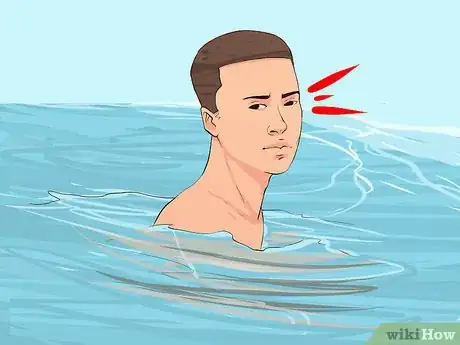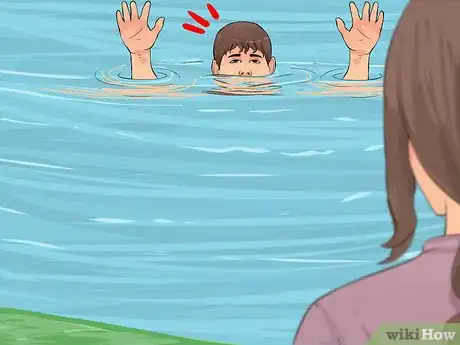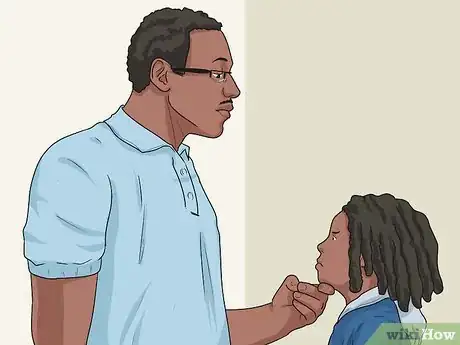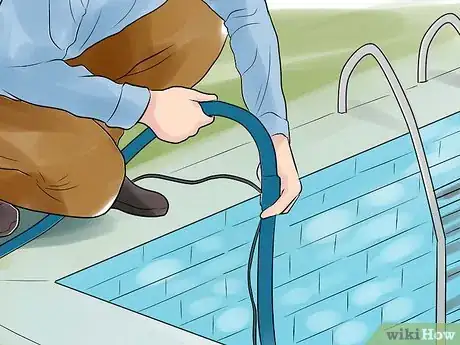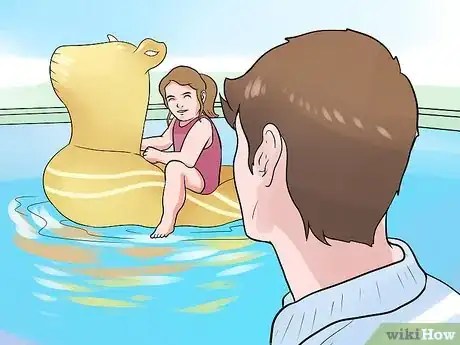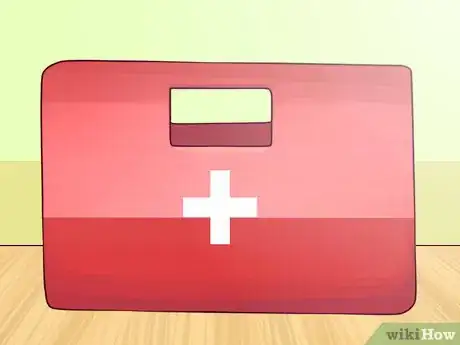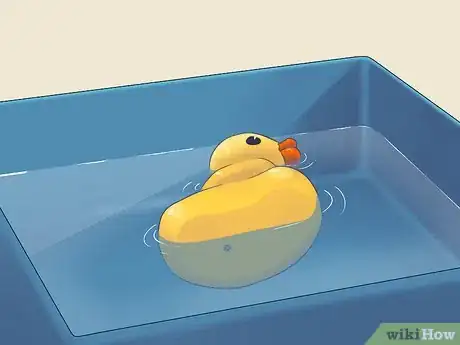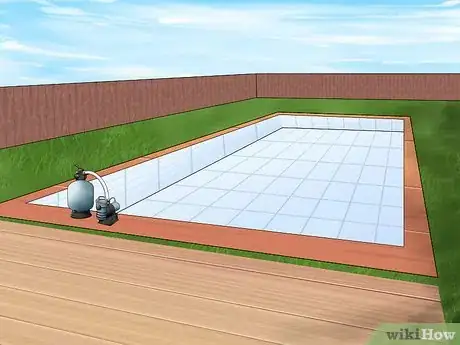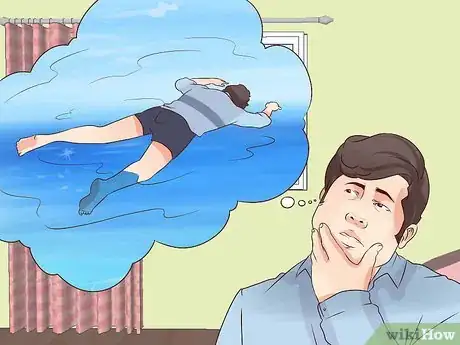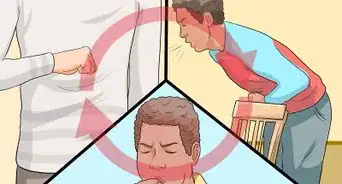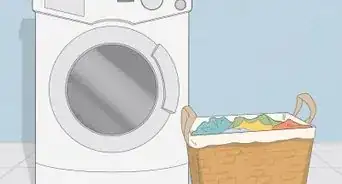This article was co-authored by Brad Hurvitz. Brad Hurvitz is a Certified Swimming Instructor for My Baby Swims, an adolescent swimming school based in La Jolla, California. Brad is trained as an Infant Swimming Resource (ISR) instructor with ISR's Self-Rescue® program. He specializes in training children aged six months to six years of age survival skills like floating on their back to breathe and swimming back to the wall, while also educating parents on how to better keep their kids safe. He has a Master of Business Administration from Oregon State University.
There are 12 references cited in this article, which can be found at the bottom of the page.
This article has been viewed 85,424 times.
Though it's not always well-publicized, drowning is one of the leading causes of death from unintentional injury, causing about 10 deaths per day in the US alone.[1] Tragically, it often happens close to home — in 2012, 73% of the drowning deaths of children under 14 years occurred at a private residence. Fortunately, by observing basic water safety standards, many situations that can lead to drowning can be completely averted. Whether you're swimming on your own, supervising others, or making your pool safe for your family, this is the knowledge you can't afford to not have.
Steps
Reducing Your Own Chance of Drowning
-
1Pick swimming sites with lifeguards. The safest choice when selecting swimming sites is ones that have lifeguards on duty. Certified lifeguards are your greatest friends of all when you're swimming — the presence of lifeguards at swimming sites has been shown to have a serious, proven effect on drowning prevention.
- A well-managed pool or beach with lifeguard supervision takes measures to head off hazards, such as knowing where dangerous undertows are and have the authority to remove teenagers playing around in an unsafe manner.
- Lifeguards are trained to spot swimmers on the verge of drowning and act quickly to save lives.
- Certified lifeguards should know how to perform CPR, which means that they have the potential to save a swimmer's life even in the dangerous situation that they lose consciousness in the water.
- However, lifeguards should be treated as a fire extinguisher — critical if needed, but one should do everything possible to avoid having to use one. Take all safety measures you would take even if the lifeguard was not there. [2]
-
2Learn basic swimming skills. For obvious reasons, knowing how to swim can greatly reduce your risk of drowning. For absolute beginners, skills like the crawl stroke and treading water can allow you to move and float with ease in the water, improving your confidence and security while you swim. Do not rely solely on the "doggie paddle" to prevent yourself from drowning — it's not as effective or energy-efficient as actual swimming strokes. However, it is better than not swimming at all!
- If you are not a confident swimmer, consider enrolling in swimming lessons. Swimming lessons are estimated to reduce the risk of drowning by 88% in very young children but can provide life-saving knowledge even to adults.
- Swimmers can still drown. Just being able to swim does not mean you are immune from drowning. This statement is not to discourage anyone from learning to swim - just that over-confidence can be every bit as dangerous as an inability to swim at all. "Drown-proofing" does not exist.
Advertisement -
3Use certified flotation devices. Life jackets and other flotation devices can keep their wearer afloat in the water even if they are unconscious or unable to swim, making them a valuable aid in and around the water.[3] For some situations, flotation devices may even be a legal necessity — in the United States, for instance, many states require boaters to wear a properly-fitted life jacket (or at least have one for each person onboard). Usually, these life jackets will need to be certified by the US Coast Guard to be considered valid.[4]
- Do not rely on "water wings", foam noodles, and other pool toys to keep you afloat — these are not designed to keep non or weak swimmers from going under.
- Even if you are a strong swimmer, wear your life jacket in boating situations. In the event of a capsize, for instance, if you are struck unconscious the lifeguard can save your life.
-
4Recognize and avoid strong currents. If you have done most of your swimming in man-made pools, it's easy to forget that bodies are often subject to the forces of natural currents. If these currents are strong enough, they can pose serious dangers, especially to weak or inexperienced swimmers. Particularly dangerous are "rip currents," strong, fast currents that occur near to shore and can pull swimmers out to sea. If you're at the beach, be ready to spot these common rip current warning signs:[5]
- A narrow channel of particularly choppy water
- Water with a noticeably different color than the water around it
- Irregular wave patterns
- A line of debris or seaweed moving steadily out to sea
-
5Don't panic if you find yourself in a strong current. In the unlikely event that you are caught in a strong current, knowing how to react intelligently can save your life. Though this can be a very scary experience, try your best not to panic — in this case, letting your instincts take over can be a bad idea. Rather than trying to fight the current, instead, turn 90 degrees and swim parallel to the shore as hard as you can. Since most rip currents are active only in relatively narrow channels, eventually, you'll get out of the rip current and into calmer waters.
-
6If you feel yourself start to lose control, tread water or float. Most people's natural reaction to the sensation of beginning to drown is to fight as hard as they can to keep their heads high above the water.[6] Unfortunately, this is one of the worst things to do when you're drowning — it can quickly deplete your energy reserves, tire you out, and actually make it harder to signal for help. Usually, it's a much better idea to tread water or use a floating technique to conserve energy so that you can make a try for the shore or signal for help.
- To tread water, turn yourself upright in the water and make an in-and-out sweeping motion with your arms to stabilize your upper body. As you do this, make an easy, bicycle-like kicking motion to keep yourself afloat.
- If you're completely out of energy, using a survival float can allow you to rest in the water. Turn prone (face-down) and spread your limbs out wide, using only minimal movements to keep yourself afloat. Lift your head when you need to breathe.
- Keep in mind that you only need to keep your mouth a little out of the water to be able to breathe — fighting to stay high in the water is usually a waste of energy.
-
7Don’t use drugs or alcohol. Being impaired in the water is a sure-fire recipe for danger. Alcohol, in particular, can be a very bad choice — not only does it impair your judgment and motor skills, but it also makes you more susceptible to hypothermia (injury or death from getting too cold).[7] However, because many drugs' effects can be just as bad (or worse), it's a bad idea to get in the water when you're under the influence of any sort of psychoactive substance, so stay sober when you're swimming.
Preventing Others from Drowning
-
1Learn CPR. CPR, or Cardiopulmonary Resuscitation, is a very important lifesaving technique for anyone who plans to spend time around the water. CPR allows a rescuer to circulate a drowning victim's blood throughout their body and, sometimes, even restore their ability to breathe. While CPR alone can sometimes save drowning victims' lives, it can also help stave off death until emergency services arrive. CPR classes are usually brief and today can even be completed online, making it easier than ever to get the skills needed to save another person's life.[8]
- If you don't know how to do CPR, most sources recommend only attempting chest compressions, not more advanced airway-clearing techniques or rescue breathing.[9] To do chest compressions, kneel next to the unconscious victim on a hard surface and place both your hands on top of each other on his or her chest. Use your upper body weight (not just your arms) to compress the person's chest by about two inches. Perform compressions at a rate of about 100 per minute until paramedics arrive or the person regains consciousness.
-
2Designate a lifeguard or water monitor. Perhaps the single most important thing you can do to ensure water safety is to make sure there is always someone watching the swimmers in the water who is ready to jump in at a moment's notice.[10] Trained lifeguards, of course, make the best water monitors, but even an ordinary strong swimmer can make do in a pinch.
- If your water monitors are worried that they won't be able to join in the fun, try taking shifts! Just don't let anyone drunk or otherwise impaired be your monitor — saving someone from drowning can be a game of seconds, so you don't want anyone with a slowed reaction speed to be your lifeguard.
-
3Know who’s most at risk. On the individual level, a person's swimming ability and the conditions they're swimming in usually determine whether or not a person is at risk for drowning. When dealing with very large numbers of people, however, it's possible to observe certain demographic trends with regards to drowning rates — essentially, certain types of people are more likely to drown than others. Below are just a few different types of people that, statistically, are more prone to drowning than the baseline average rate:[11]
- Children: Very young children (ages 1-5) are especially susceptible to drowning. In fact, drowning is the leading cause of death under the age of 5.[12]
- Men: Men make up more than 80% of all drowning fatalities. It is unclear if this is due to a greater preference for risk-taking behavior, biological abilities, or simply a greater preference for swimming.
- Urban poor/minorities: In the United States, certain socioeconomic groups have disproportionately high rates of drowning deaths due to factors like lack of access to swimming pools and lack of water-based recreational activities. For instance, African American children 5-19 drown in swimming pools almost six times more often than whites.
-
4Be aware of any swimmer’s medical disorders. If a person has a medical condition that may give them decreased motor function or otherwise impair them while they're in the water, this is information that should definitely be told to the water monitor before swimming begins. For instance, conditions like epilepsy can leave someone helpless in the water if they have a seizure, so the water monitor should keep an extra close eye on these people. In addition, if there is any sort of equipment that's necessary for quick, lifesaving treatment of the condition (for instance, EpiPens for people with severe allergies), you'll want to have this equipment available in the event of a worst-case scenario.
-
5Be aware that drowning is often a silent phenomenon. Drowning often doesn't occur the way it appears in movies — as a loud, violent, chaotic struggle to stay above water. In fact, someone who's in the process of drowning may be unable to get their head above the water long enough to even call for help. Because of this, there usually won't be any sort of warning sounds that drowning is occurring.[13] A person may even drown without the people next to them knowing that anything is wrong until it's too late. For this reason, it's extremely important for the water monitor not to let their visual attention wander from the swimmers they're supposed to be watching. Know the following warning signs of silent drowning:[14]
- Stiff, upright body with arms pushing down against the water (not waving or signaling for help)
- The inability for the drowning person to speak (they are focusing on breathing)
- Periods of intense struggling on the surface followed by submerging underwater with breath held
- The inability for the drowning person to keep their mouth above the water consistently
Drowning Prevention For Children Under 5
-
1There is no such thing as "drown proofing" or "safety proofing" children. Being able to swim proficiently does not mean a child (or adult) cannot drown. Learning about water safety at swim lessons does not mean that they will not do something unsafe the very same day. Let your children learn the basic water safety rules and review them anytime they need to go to a spa or pool.
-
2Never let children swim unsupervised. While it's a bad idea for anyone to swim alone, for children, it should be a hard and fast rule. Never let children swim without adult supervision, no matter whether they're at the beach, in your household pool, in a public pool, or at a friend's house.[15] [16] Even young children who have received swimming lessons can be more vulnerable to drowning than older children who haven't, so supervision is key to keeping your children safe until they're mature, responsible swimmers on their own.
- Supervised means watching without distractions; no phone, tablet, book, or the like. It is one thing to make a quick text, but if you are absorbed in a game on your device, you are not really paying full attention to your child.
- Ensure the distance between you and your toddlers is arm’s length while the child is in the pool even when he/she has a floating device. Floating aids are not as secure as approved life vests, and they can give adults and children the wrong sense of security.
- If you’re leaving your child with a babysitter or a teenage supervisor, make sure they know your water safety rules. Be especially sure to remind them that drowning often has no audible warning noises, so visual supervision is necessary.
-
3Make your pool area safe and the pool inaccessible while you are not swimming. Putting physical barriers like a pool fence between your children and your pool can often be enough to keep them out of it when you're not there to supervise them. Young children are attracted to pools and don't understand the danger. Below are just a few basic ideas for kid-proofing your pool:
- Keep ground-level pools fenced off with at least 4 feet high fence. Use playpens, iron, chain link, or mesh pool fences to form a protective barrier around your pool.
- Use a self-closing, self-locking pool gate. If you don't have a self-closing gate, be sure to lock any gates or doors in the fencing after swimming
- Remove ladders for above-ground pools. If your children are too small to climb into above-ground pools without a ladder, simply take the ladder away to keep them out.
- If possible, use a cover or lid for your pool. Many pools and hot tubs come with hard lids or plastic covers. Usually, these are used for weatherproofing the pool when not in use, but they can also be an effective deterrent against children if they're sturdy enough to keep them out.
- Always ensure the spa and pool covers are working, and the walkways surfaces such as diving boards, ladders, decks are non-slippery. Replace or reinforce in case there is a wear-out.
- To avoid injuries in the pool, cover all sharp edges and raised hard surfaces.
- Keep all electrical devices away from the spa or pool to avoid electrical shock. Ensure all the wiring is maintained and is installed professionally.
- Do not go to the pool during rough weather like high winds or thunderstorms
-
4If you cannot spot a child, rush to the spa or the pool first, time is crucial!
- You can install an underwater or surface alarm that will alert you when someone fell into the pool.
- You can also set gate chimes or alarms to alert you when someone opens the pool gate
- Keep tables, climbable surfaces, and chairs far to avoid children from climbing over into the pool.
-
5Have a pool safety kit for your spa or swimming pool. These include:
- Floatation device
- An emergency portable phone
- A pair of scissors
- First aid kit
-
6Never leave toys near the pool. Children are less likely to want to swim unsupervised if they are not tantalized by brightly colored toys. After finishing a trip to the beach or a swim in your backyard pool, put away and secure the toys. The prospect of swimming may become much less attractive to your children. Plus, the toys will last longer and not become a tripping hazard.
-
7Consider draining your pool. One sure-fire way to keep children from drowning in your pool is to remove the water from the equation. If the pool is completely drained, children will have less of a reason to enter it unsupervised and, even if they do, they won't be able to drown. This can be a somewhat tricky process, so, if you're unsure of how to proceed, contact a plumber or an experienced pool professional.
- Keep in mind, however, that draining some types of pools and leaving them exposed to direct sunlight can damage the plaster material at the bottom of the pool.
-
8Understand that young children can drown in very shallow water. Babies and toddlers can drown in as little as one inch of water. Tragically, not all parents and caretakers are aware of this. For this reason, it's extremely important to monitor these types of young children whenever they're around the water of any depth, including when they're in the bathtub or around buckets of water. If you need to leave for any reason, take your baby with you — the amount of time it takes for you to answer the door, for instance, can be enough time for a baby to start drowning.
- Don't rely on bathtub seats to keep your child safe in the tub. There are multiple ways these can fail — for instance, their suction cups can come unstuck from the tub or the baby may crawl out of the seat.
- Products around the house containing or collecting water can be drowning hazards. The most common of this outside are buckets or the top of pool covers which can collect rainwater. Drowning deaths have also involved ponds, sinks, fish tanks, among other products.
Expert Q&A
-
QuestionHow do I keep my children safe when they're swimming in a pool?
 Brad HurvitzBrad Hurvitz is a Certified Swimming Instructor for My Baby Swims, an adolescent swimming school based in La Jolla, California. Brad is trained as an Infant Swimming Resource (ISR) instructor with ISR's Self-Rescue® program. He specializes in training children aged six months to six years of age survival skills like floating on their back to breathe and swimming back to the wall, while also educating parents on how to better keep their kids safe. He has a Master of Business Administration from Oregon State University.
Brad HurvitzBrad Hurvitz is a Certified Swimming Instructor for My Baby Swims, an adolescent swimming school based in La Jolla, California. Brad is trained as an Infant Swimming Resource (ISR) instructor with ISR's Self-Rescue® program. He specializes in training children aged six months to six years of age survival skills like floating on their back to breathe and swimming back to the wall, while also educating parents on how to better keep their kids safe. He has a Master of Business Administration from Oregon State University.
Certified Survival Swimming Instructor The first layer of protection is supervision: always be around your child. Pay attention to your child, watch your child, etc. In this day and age, supervision is not occurring as much as it once was near a pool. People will get distracted. I've seen parents all the time on their phones on a lounge chair and their kid is just playing around on the steps. And so supervision is the most important. Secondly, it is a pool fence. It's necessary to install a permanent four-sided fence around the pool with a self-locking gate, the gate that once you push out there will be some kind of hydraulic that shuts it and locks it so your three-year-old can't enter the pool area. That will make sure that they're away from the body of water. And then beyond that, it'd be a good idea to get alarms for any of those doors so you get notified, it makes a sound, etc. After that, of course, you should invest in survival swim lessons through infantswim.com. These are certified infant swim instructors that will teach your child to roll and float on his or her back, and also turn and swim to the wall. And once these survival skills are taught, the kids have so much fun in the water and they know what to do if they ever find themselves alone in the water or if they find themselves in a challenging situation in the water. Then finally, the last layer of protection is knowing CPR. That's obviously something you never want to utilize but it's a necessity to know as a parent.
The first layer of protection is supervision: always be around your child. Pay attention to your child, watch your child, etc. In this day and age, supervision is not occurring as much as it once was near a pool. People will get distracted. I've seen parents all the time on their phones on a lounge chair and their kid is just playing around on the steps. And so supervision is the most important. Secondly, it is a pool fence. It's necessary to install a permanent four-sided fence around the pool with a self-locking gate, the gate that once you push out there will be some kind of hydraulic that shuts it and locks it so your three-year-old can't enter the pool area. That will make sure that they're away from the body of water. And then beyond that, it'd be a good idea to get alarms for any of those doors so you get notified, it makes a sound, etc. After that, of course, you should invest in survival swim lessons through infantswim.com. These are certified infant swim instructors that will teach your child to roll and float on his or her back, and also turn and swim to the wall. And once these survival skills are taught, the kids have so much fun in the water and they know what to do if they ever find themselves alone in the water or if they find themselves in a challenging situation in the water. Then finally, the last layer of protection is knowing CPR. That's obviously something you never want to utilize but it's a necessity to know as a parent.
References
- ↑ http://www.cdc.gov/homeandrecreationalsafety/water-safety/waterinjuries-factsheet.html
- ↑ http://www.personal.psu.edu/msp5018/blogs/english_202c/How%20to%20Perform%20CPR.pdf
- ↑ http://www.redcross.org/prepare/disaster/water-safety/swim-safety
- ↑ http://www.rei.com/learn/expert-advice/personal-flotation-device.html
- ↑ http://ripcurrents.noaa.gov/overview.shtml
- ↑ http://www.sutcliffe.ca/joel/nls/drowning.pdf
- ↑ https://www.drinkaware.co.uk/check-the-facts/effects-on-your-safety/drinking-alcohol-in-cold-weather
- ↑ http://www.redcross.org/take-a-class
- ↑ http://www.mayoclinic.org/first-aid/first-aid-cpr/basics/art-20056600
- ↑ Brad Hurvitz. Certified Swimming Instructor. Expert Interview. 13 February 2020.
- ↑ http://www.cdc.gov/homeandrecreationalsafety/water-safety/waterinjuries-factsheet.html
- ↑ Brad Hurvitz. Certified Swimming Instructor. Expert Interview. 13 February 2020.
- ↑ Brad Hurvitz. Certified Swimming Instructor. Expert Interview. 13 February 2020.
- ↑ http://news.msn.com/science-technology/drowning-101-knowing-the-signs-and-symptoms-could-save-a-life
- ↑ http://kidshealth.org/parent/firstaid_safe/home/safety_drowning.html
- ↑ Brad Hurvitz. Certified Swimming Instructor. Expert Interview. 13 February 2020.
About This Article
To protect yourself from drowning, always choose swimming spots where lifeguards are on duty. If possible, take swimming lessons so you can master a few basic skills before you hit the water. Even if you’re a trained swimmer, wearing a floatation device such as a lifejacket is a good way to stay safe in the water. Strong currents are a common cause of drowning, so watch out for choppy water or irregular wave patterns if you’re swimming in a lake, river, or ocean. If you do get caught in a current, try not to panic. Do your best to calmly float or tread water, and swim with the current parallel to shore until you’re able to make your way to calmer waters. Keep reading for tips on how to protect others from drowning.





